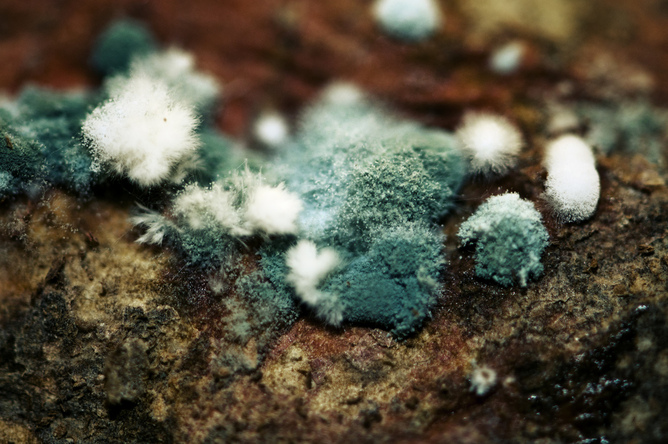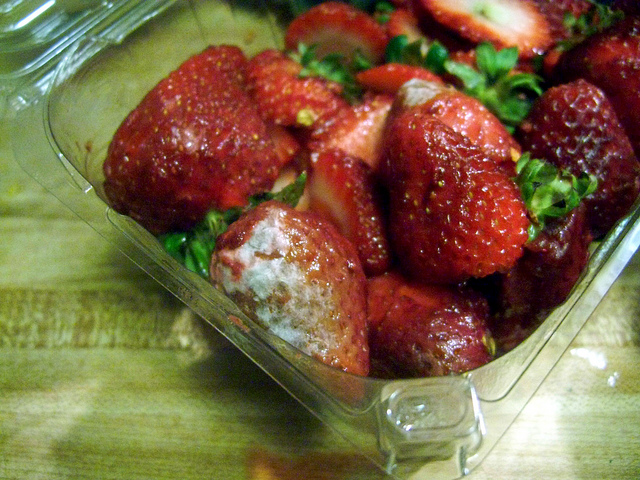Find out why mould on food can be toxic - and when you need to cut it off, or throw it out.

Good news for vintage cheese lovers. Image: TheeErin
The short answer is that it’s a lot safer than not cutting it off.
Some moulds make and release poisons, called mycotoxins, into the food that could, over time, make you very sick. Why they do it is not especially well understood but that doesn’t make it any safer.
Some mouldy foods should simply be discarded (ideally, to compost). For others, though, you can salvage and use the unaffected parts without exposing yourself to a health risk. That’s good if your mouldy food is an expensive, vintage cheddar cheese!
The life of moulds
Moulds are fungi. They’re related to mushrooms, and the yeasts we use to make bread, or convert sugars to alcohol. They are heterotrophs, meaning they can’t make their own food (unlike plants). Instead, they degrade complex organic molecules in their environment into smaller molecules they can absorb to meet their energy and nutrient needs.
In nature, mould’s ability to break down detritus (waste) ensures that dead matter doesn’t accumulate. It also enables the release of minerals that are chemically tied up in detritus to the plants that need them for their primary production.
Moulds are single-celled organisms and, individually, are microscopic. When water and nutrients are available (such as in semi-perishable foods) they grow in number: to procreate, mould cells simply make copies of all essential cell components, and then divide into two new (genetically identical) “daughter” cells.
When moulds divide the two cells stay connected and when they divide again and again, they form a long chain of cells, called a hypha. The hyphae can branch and collectively form a complex matrix called a mycelium that, when big enough, can be seen with an unaided eye. This is the furry growth we can see, for example, on crumpets, berries, jam, tomato paste, cheese, and so on.

Not all moulds on foods will produce mycotoxins, or produce them at harmful levels. Image: Sleepy Gonzales
The growing tips of the hyphae release enzymes into the environment to degrade complex organic molecules into usable nutrients. The tips of the hyphae also release the mycotoxins which are probably released to ward off competitors.
So, wherever the mycelia go in search of nutrients, toxins may also be found. The extent of spread of the mycelium is not always visible, however, and herein lies the problem.
What to do?
Many moulds can grow on, and spoil, our foods. Among those we are likely to encounter on foods in our homes are Penicillium (“cousins” of those used to make antibiotics, or to ripen some cheeses), Aspergillus, and on fruits, Botrytis.
You’re unlikely to experience any immediate symptoms from ingestion of mycotoxin-contaminated foods. Ongoing exposure increases the chances of a range of diseases including include kidney, liver and immune system damage, increased risk of a range of cancers and neurological symptoms; though these worst-case scenarios are rare.
Not all moulds on foods will produce mycotoxins, or produce them at harmful levels, but without a microscope and laboratory its hard to distinguish the dangerous and harmless ones. Given the risk to your health its best to take a very cautious approach to visible mould growth on any food with some exceptions.
A good rule of thumb to judge whether a mouldy food can be “saved” is its moisture content or firmness. Foods with a high moisture content such as cooked casseroles, soft fruit and vegetables, pastes/sauces and soft cheeses can have invisible hyphae growing below the surface and producing mycotoxins.

Time for composting. Image: Jo Naylor
The same is true for porous foods such as bread and cakes where the hyphae can penetrate. All of these foods should be discarded if you see mould on the surface.
Conversely a cheddar, or a salami, or carrot, that have dense structure are less likely to have extensive hyphal growth away from the visible mycelium. In these cases the mycelium can be cut away (to a centimetre or two depth) and the remaining food consumed with little risk.
The United States’ Department of Agriculture’s website is a good source of advice for dealing with mould contamination on a wide variety of foods.
The authors do not work for, consult to, own shares in or receive funding from any company or organisation that would benefit from this article. They also have no relevant affiliations.
This article was originally published at The Conversation. Read the original article.
Clarification 25/02/2014:
Cutting away portions of food is not a safe way to deal with other food safety risks such as contamination or bacterial growth. It should not be used on products beyond their use by date or where products have not been stored correctly. And when in doubt throw it out.
***
CSIRO also produced a range of infographics covering food safety, health tips and recipes. Check out the ‘Be Food Safe’ Health Bite below:



10th March 2014 at 10:06 pm
Have to sort of agree with almost everyone. It was a good and clear article by Ailsa and, from personal experience, a very conservative one. To fully protect the fundemental orifice, one would have to put in so many caveats, explanations and additional information that the body of the article would get lost. In fact, I would defy anybody to write anything that couldn’t be misinterpreted.
Perhaps it would be more salutory to have an article on what is an acceptable level of risk, bearing in mind that zero risk is impossible.
8th March 2014 at 12:03 pm
Just read the Clarification to the Article above where I see a good example in two written words ” stored correctly “. This, I would suggest is an assumption that all readers would know such information or would seek it out. Even so, love the article.
8th March 2014 at 11:44 am
Hey, all good comments by those above and I agree. I learnt to write such articles above as a professional, especially those intended for the farming community. After some 55 years research and tech transfer, I have learnt to listen to what others may be ‘hearing’ in what I write. Perhaps this is a moment to consider not only proof reading of such material, but also ‘goof reading’ by a third party (which in a sense is exactly what has been done in the other comments above; we know what we mean when we write, but others may read/understand it differently). As a footnote: someone thought I was insulting the author with the word ‘goof’, so hence the section in brackets, which I do hope clarifies that! Yes?
7th March 2014 at 12:51 pm
The majority of reporters in the general media when putting 1 & 1 together generally get 10 so I think maybe erring on the side of caution is a good idea. We used to play “Chinese Whispers” at school, which quickly highlighted the folly of “not spelling it out”
9th February 2014 at 8:35 pm
Hi, just for the authors, I strongly disagree that salami and deli meats are safe to eat with mould. The mould is a marker for bacterial growth too and this includes listeria and toxigenic E coli. I think this article should be amended to state this as it is NOT safe to eat these foods.
10th February 2014 at 12:25 pm
Hi Vivienne, the salamis we are thinking of are those that are mould ripened – i.e. the mould is just on the outer skin. Generally it is safe to wash the mould off the rind of these salamis. I agree that mould on other types of deli meat is undesirable. It depends a lot on the moisture content (water activity) of the product whether Listeria and E. coli may also be present.
10th February 2014 at 1:31 pm
Yes, but this isn’t clear, perhaps it should be amended, esp re sliced deli meats and sliced salamis.
10th February 2014 at 4:36 pm
I agree with Vivienne about this being unspecific in the article. True, the wording is “a salami”, which implies a whole, unperturbed salami. But surely it’s better to be safe than sorry when giving new advice.
10th February 2014 at 4:45 pm
The article clearly says: “Conversely a cheddar, or a salami, or carrot, that have dense structure are less likely to have extensive hyphal growth away from the visible mycelium. In these cases the mycelium can be cut away (to a centimetre or two depth) and the remaining food consumed with little risk.”
It’s not possible to cut off a cm or 2 in depth with salami that is not in a single piece.
10th February 2014 at 6:13 pm
This may be so, but unfortunately the general media (news.com.au and other sites) are not going into this detail and so people are getting erroneous information. This is why I have bothered to contact you!!!
10th February 2014 at 5:25 pm
It does say that, and I’d hope everyone takes the full picture into account. But some distracted people might recall, in a mouldy salami moment, only that mouldy salami should be fine.
10th February 2014 at 5:40 pm
It’s not an error or omission in the article, it just struck me as being misinterpretable.